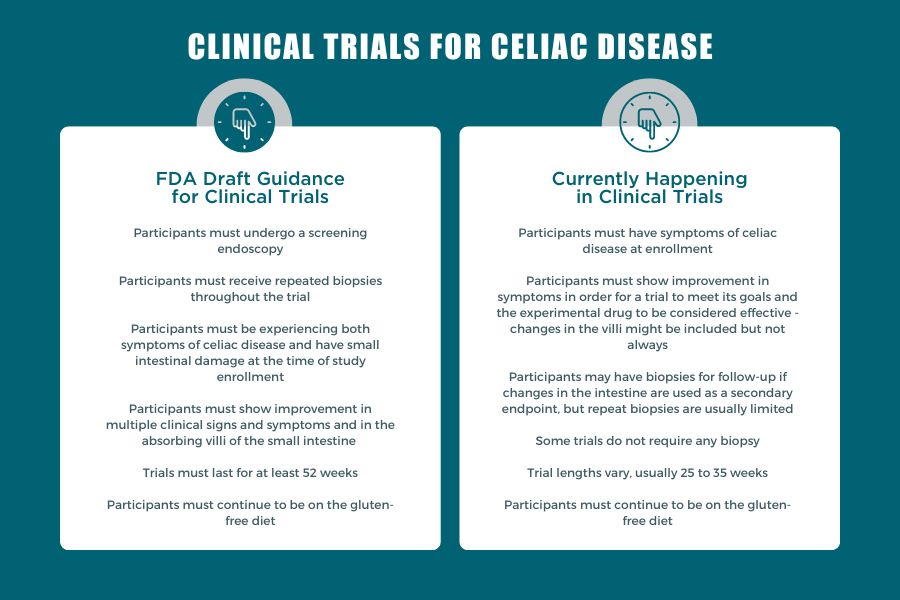FDA Releases Draft Guidance on Clinical Trials for Celiac Disease
May 27, 2022

The FDA released draft guidance in April about how celiac disease clinical trials should be conducted. In the US, the FDA oversees all clinical trials of new drugs and gives approval for drugs to be made available to patients after they go through clinical trials. The draft guidance released in April is about clinical trials for celiac disease treatments to be used in addition to the gluten-free diet. Currently, there are many drugs in the drug development pipeline that are designed to be used in this way.
Below, we have summarized what draft guidance from the FDA means, as well as what the new draft guidance proposes compared to what is currently happening with clinical trials.
What is draft guidance from the FDA?
Guidance documents prepared for FDA staff, regulated industry, and the public describe the agency’s interpretation of or policy on a regulatory issue. They represent the FDA’s current thinking on a topic, in this case on clinical trials for drugs to treat celiac disease. Draft guidance usually discusses more specific issues related to, for example, testing of regulated drugs. Draft guidance is not binding, and undergoes a public comment period. The FDA may then decide to change their guidance based on comments, before issuing a final guidance document.
What does this draft guidance say?
In clinical trials for the development of a treatment to be used in addition to the gluten-free diet, the draft guidance recommends that adults who participate:
- Undergo a screening endoscopy even if they previously had one done for diagnosis or as part of follow-up, to ensure that they have evidence of active celiac disease as shown in a biopsy.
- Are experiencing both symptoms of celiac disease and have small intestinal damage at the time of study enrollment.
- Receive the experimental drug (or placebo) for a period of at least 52 weeks.
- Show improvement in multiple clinical signs and symptoms (the clinical endpoint) and in the absorbing villi of the small intestine (the histological endpoint) in order for the trial to meet its goals and the experimental drug to be considered effective. A trial would not be considered successful if participants experience improvement in signs and symptoms alone or intestinal villi improvement alone.
- Receive repeated biopsies (e.g., during screening period, before and after a gluten challenge when it applies, and after 52 weeks of treatment) to assess changes in the small intestine.
- Continue to be on the gluten-free diet. The draft guidance only covers clinical trials that test drugs used in conjunction with, not as a substitute for, the gluten-free diet. Some studies may also include a gluten challenge.
What is currently happening in celiac disease clinical trials?
For comparison, those with celiac disease who are currently participating in most clinical trials:
- Have symptoms of celiac disease at enrollment. Some trials require a baseline biopsy at enrollment to measure small intestinal damage, but others do not.
- Have to show improvement in symptoms in order for a trial to meet its goals and the experimental drug to be considered effective. Usually, the symptoms being measured are gastrointestinal symptoms. Changes in the villi might be included as a secondary endpoint.
- Have biopsies for follow-up if changes in the intestine are used as a secondary endpoint, but repeat biopsies are usually limited. Some trials do not require any biopsy.
- Participate in the clinical trial for a varying length of time, usually 25 to 35 weeks.
- Continue to be on the gluten-free diet, as clinical trials currently being conducted in celiac disease are only for drugs used in conjunction with, not as a substitute for, the gluten-free diet. Some studies may also include a gluten challenge.
What’s next?
The open comment period on this draft guidance runs until June 14, 2022. Anyone can submit a comment, and Beyond Celiac plans on submitting a public comment. You can read the full draft guidance document and leave a comment on this page.
